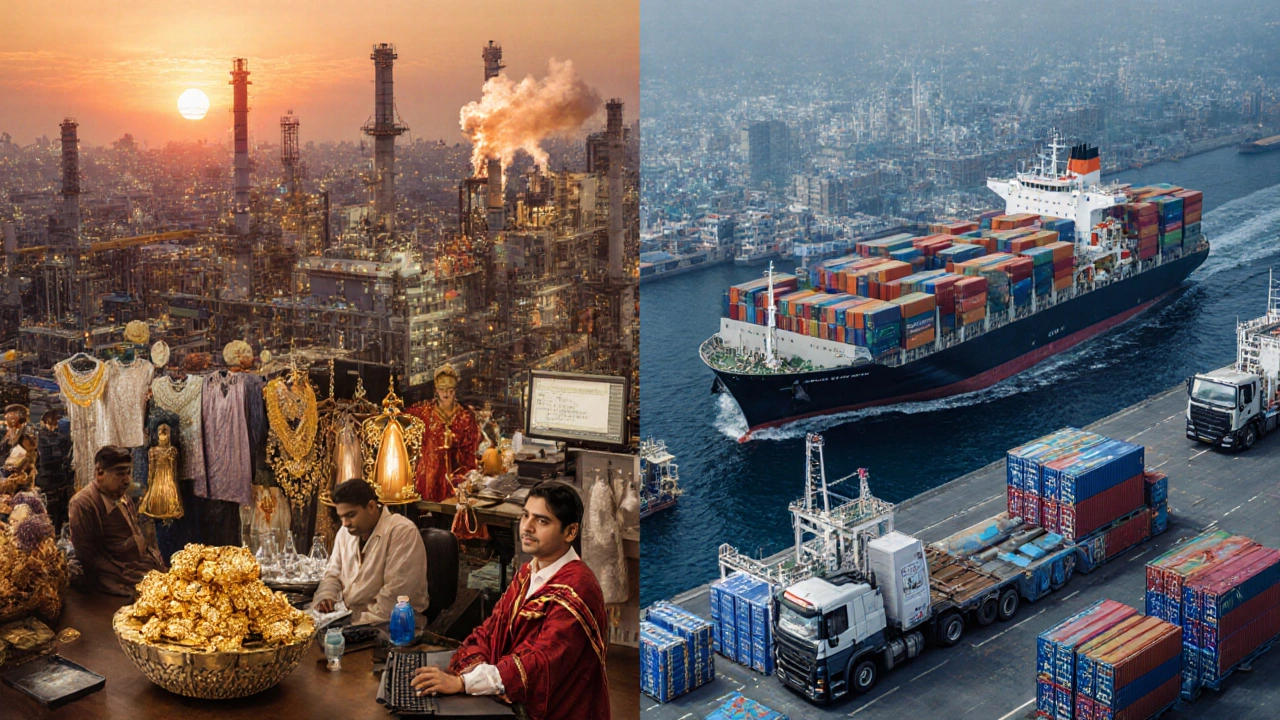India Trade Explorer 2025
Total Trade Value
$1.1T
2024-25 Fiscal Year
Trade Deficit
$80B
Goods Trade Deficit
Top Export Categories
Top Import Categories
Key Insights
- Services trade posted a $45B surplus, mainly from IT-enabled services
- Petroleum products and gems/jewelry account for ~30% of exports
- Energy imports represent ~40% of total import value
- Exports grew 8.4% YoY; imports grew 4.2% YoY
Top Export Destinations
| Country | Value ($B) |
|---|---|
| United States | 85 |
| United Arab Emirates | 68 |
| China | 55 |
| European Union | 52 |
| Hong Kong | 44 |
Top Import Sources
| Country | Value ($B) |
|---|---|
| United Arab Emirates | 98 |
| Saudi Arabia | 77 |
| China | 65 |
| United States | 53 |
| Germany | 48 |
Trade Policy Highlights
The Foreign Trade Policy 2025-30 aims to increase high-tech exports to 18% of total exports by 2030 through incentives for medical devices and green manufacturing.
India is a South Asian nation with the world’s fifth‑largest economy, moving billions of dollars in goods and services each year. If you’ve ever wondered what the country actually ships out and brings in, you’re in the right spot. Below you’ll get a clear picture of the main export and import items, the biggest trading partners, and how the numbers have shifted in the latest fiscal year.
Quick Takeaways
- Petroleum products, gems & jewelry, pharmaceuticals, textiles and IT services dominate India’s exports.
- Crude oil, gold, electronic components, machinery and organic chemicals are the top imports.
- The United States, United Arab Emirates, China, Saudi Arabia and the European Union are the five biggest trade partners.
- India recorded a trade surplus in services (mainly IT) but a persistent goods deficit, especially in energy.
- 2024‑25 saw export growth of 8.4% year‑on‑year, while import growth slowed to 4.2% amid lower oil prices.
India’s Trade Landscape at a Glance
In the 2024‑25 fiscal year, India’s total merchandise trade crossed US$1.1trillion. Exports accounted for roughly US$670billion, while imports summed to about US$750billion, leaving a goods deficit of around US$80billion. Services trade, however, posted a surplus of US$45billion, largely driven by the IT‑enabled services sector.
The country’s trade policy continues to focus on “Make in India” manufacturing, diversification of import sources, and expanding digital services. These strategies shape the composition of both exports and imports.
Top Export Goods
India’s export basket is a mix of traditional commodities and high‑value services. The five leading categories by value are:
- Petroleum products - refined fuels and lubricants, largely re‑exported after processing.
- Gems and jewelry - diamonds, gold ornaments, and precious stones, especially to the US and EU.
- Pharmaceuticals - generic medicines and active pharmaceutical ingredients (APIs).
- Textiles and apparel - cotton garments, synthetic fabrics, and home textiles.
- IT services - software development, BPO, and cloud solutions.
Collectively, these sectors contributed about 62% of total export earnings. Petroleum products, despite being a refined export, rely on imported crude, making them a unique case of value‑addition.

Top Import Goods
India’s import profile reflects its growing energy needs, raw material requirements, and technology upgrades. The five biggest import categories are:
- Crude oil - fuels electricity generation, transport and petrochemical plants.
- Gold - demanded for jewelry, investment, and reserve assets.
- Electronic components - semiconductors, circuit boards, and mobile phone parts.
- Machinery - capital equipment for manufacturing, construction and agriculture.
- Organic chemicals - feedstocks for pharma, agro‑chemicals and plastics.
Energy imports alone represent roughly 40% of total import value, underscoring the strategic importance of diversifying fuel sources.
Leading Trade Partners
India’s trade is spread across many countries, but a handful dominate the volume.
| Country | Export Value (US$bn) | Main Products |
|---|---|---|
| United States | 85 | Pharma, IT services, Gems |
| United Arab Emirates | 68 | Petroleum products, Gold |
| China | 55 | Textiles, Organic chemicals |
| European Union | 52 | Pharmaceuticals, Machinery |
| Hong Kong | 44 | Jewelry, IT services |
On the import side, the top five sources are:
| Country | Import Value (US$bn) | Main Products |
|---|---|---|
| United Arab Emirates | 98 | Crude oil, Gold |
| Saudi Arabia | 77 | Crude oil |
| China | 65 | Electronic components, Machinery |
| United States | 53 | Machinery, Organic chemicals |
| Germany | 48 | Machinery, Vehicles |
The UAE’s dual role as a major export destination and import source highlights its status as a hub for re‑exports.
Recent Trends and Policy Shifts (2024‑25)
Two trends are reshaping India’s trade numbers:
- Energy transition. With global oil prices dipping 12% in 2024, India’s import bill shrank, allowing a narrower goods deficit. Simultaneously, the government’s push for renewable energy has increased imports of solar panels and wind turbine parts.
- Digital services boom. IT‑enabled services grew 9.7% YoY, driven by higher demand for AI, cloud migration and cybersecurity from North America and Europe.
Policy-wise, the “Foreign Trade Policy 2025‑30” introduced new incentives for export of medical devices and for “green” manufacturing, aiming to lift the export share of high‑tech goods to 18% of total exports by 2030.

Understanding the Trade Balance
While the goods side shows a deficit, the overall balance (goods+services) turned slightly positive in 2025, mainly because services surplus offset the goods gap. This pattern is typical for a large, services‑oriented economy.
For businesses, the key takeaways are:
- Exporters of pharmaceuticals and IT services can leverage bilateral agreements that reduce tariffs with the US and EU.
- Import‑heavy sectors like energy should watch policy shifts toward renewable subsidies and explore hedging strategies.
- SMEs looking to break into textiles can benefit from “Make in India” clusters that provide tax breaks and infrastructure support.
Practical Checklist for Stakeholders
- Identify which of the top five export categories matches your product line.
- Map your supply chain against the top five import sources to spot diversification opportunities.
- Monitor RBI’s foreign exchange regulations for any changes affecting cross‑border payments.
- Tap into government schemes like the Merchandise Exports from India Scheme (MEIS) for cash incentives.
- Stay updated on WTO negotiations that could alter tariff levels for key commodities.
Frequently Asked Questions
What are India’s biggest export products in 2025?
The top five export categories by value are petroleum products, gems and jewelry, pharmaceuticals, textiles and apparel, and IT‑enabled services. Together they represent about 62% of total export earnings.
Which countries does India import most from?
The United Arab Emirates, Saudi Arabia, China, the United States and Germany are the top five sources, accounting for roughly 55% of total import value.
Has India’s trade surplus turned positive?
In 2024‑25 the overall balance (goods plus services) was marginally positive because the services surplus-mainly from IT-offset the goods deficit.
What impact did lower oil prices have on India’s trade?
Crude oil prices fell about 12% in 2024, shrinking the import bill and narrowing the goods trade deficit by roughly US$15billion.
How can small manufacturers benefit from India’s trade policies?
The government’s “Make in India” incentives provide tax holidays, capital subsidies and easier access to export credit for SMEs producing textiles, electronics, or medical devices.





Write a comment